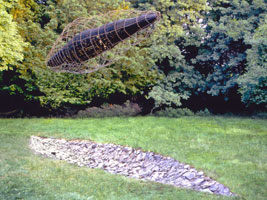| home |
| statement |
| work |
| articles |
| résumé |
| contact |

1999 Biennial Exhibition of Public Art
ON the route from the entrance of Purchase College to the Neuberger Museum of Art on the college's campus here, a visitor to the "1999 Biennial Exhibition of Public Art" is greeted first by a field of roses and then by tinkling bells. It is har to imagine any beginning more festive. The viewers' good mood will be sustained: the 17 sculptures sited on the grounds are diverse and smart in their own way.
Most of the artists come from New York City but many parts of the country ar represented. Dennis Oppenheim's choice of a stretch of grass is an obvious one for the faithfully rendered but outsize fiberglass roses painted a variety of lipstick colors. Sometimes Mr. Oppenheim, is mischievous, but here he is simply dazzling. Bill and Mary Buchen are responsible for the bells, which are no bigger than motes dangling from the bobbing crosspieces of five streamlined steel shafts. The bells are hardly noticed, but their sound does much to humanize the austerity of the Buchens's construction.
Hugging the museum facade is "Family of Five" by Jim Roche. If it were stripped of its wealth of hardware like metal signs, tools and hubcaps, it might be a five-paneled screen. As it is, Mr. Roche has arranged his evocative elements symmetrically, so that each side of the work has a mask-like face. Kenneth Snelson' bunched aggregate of stainless steel pipes is the centerpiece in the museum's courtyard. In back of the museum is a bucolic tract of grass and trees. The place has a history: it was a homestead in the 17th and 18th centuries, and archeology classes at the college find it a rich dig. Susan Crowder pays homage to this past in the faithful kitchen garden that she has sown. A blocky, figurative sculpture by Kenta Fushara recalls his childhood, and a small boy stands among the nexus of fiberglass figures. A snake weaves through the crowd, and surely symbolizes a loss of innocence. Lynda Benglis's tall, scaly bronze work might be an abstraction of a running figure. Mary Miss saw the potential of a massive dark purple beech tree on the edge of the field. She built a hefty 132-foot ladder, which remains parallel to the ground but leads the eye toward the tree. This exhilarating perspectival rush heightens the splendor of the tree.
John Monti and Michael Bramwell flipped a coin over who would get an enclosure with a low stone wall and small, shallow concrete basin. The result was the correct one. For "Lemon Float," Monti painted the interior of the basin bright blue, so that it resembles a swimming pool. Flanking it are two Oldenburg-like lemons of fiberglass and rubber, which viewers, with some effort, can roll around. The totality is a burst of summer in a dark glade. It helps to know that Mr. Bramwell, who chose a spot adjacent to the one he coveted, is known for conceptual pieces in which he sweeps out historic places. He has evidently taken a broom to the three large squares of ceramic floor tile. Since the work is called "Three Squares (for the Boys on Rikers Island)," soaring over the squares is a clothesline on which many pairs of sneakers hang.
Some of the artists were spurred by the desolate classroom building area of the college campus. In an open plaza, Buster Simpson installed a working grindstone with the words "hone" and "wear" inscribed on either side of the sandstone wheel. The relevance of this piece to the educational process is obvious. On a stark building facade, Jackie Chang installed a mock awning like those that hang over the entrances to neighborhood stores. It has five components whose writing advertises made-up enterprises with an idealistic bent.
One of the stores is Brave New World Video; another is Utopia Barbecue. Covering a light steel framework with a lightweight nylon wind screen, colored the appropriate shade of dark green, Lee Boroson created a mock hedgerow, configured like a maze. The artificiality of his materials mocks the sterility of this side of the campus."Hedge" is installed on a long, bare plaza. At the very least, having to negotiate Mr. Boroson's labyrinth will add a bit of variety to one's usual route across campus.
Jun Kaneko chose to beautify the place by creating a hefty ceramic sculpture, which apparently has no seams, leading to the conclusion that it was fired in one piece. A colorfully patchwork surface of parallel lines, running horizontally, vertically and diagonally, it relates to the brickwork of the college buildings, but it also shows in stern angularity how to have a good time. To that end, Siah Armajani provides a long picnic table with an outsize wheel hooked to one side of it. Meanwhile, in a nearby forested area, which resembles a pavilion because of the high trees that admit light, is a lectern on which Mara Scrupe has written a rather cryptic poem about mankind's alienation from nature. At night the lectern is lighted by a solar unit, standing in the open some distance away, and the message shines, proving that this artist is able to practice the reconciliation she preaches.
The "1999 Biennial Exhibition of Public Art" is at the Neuberger Museum of Art through Oct. 24.
The
number to call for information is 251-6100.
The New York Times